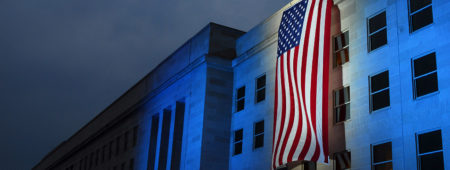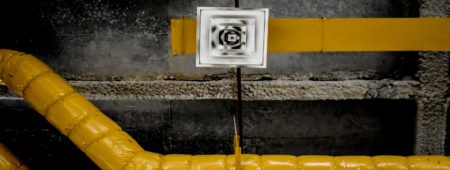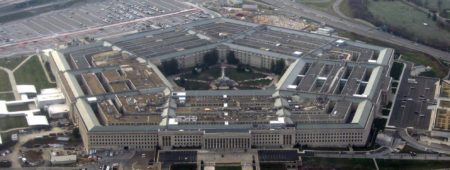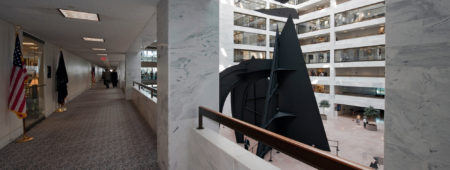
Preventing Terrorist Attacks

Buildings are often considered a safe zone: a place to find shelter, where we gather for events, a place to get groceries. But they are also prime targets for terrorist attacks—especially buildings for military personnel or government employees.
A building’s heating, ventilation, and cooling system, known as HVAC, is a point of weakness that we know terrorists can exploit. An HVAC system can distribute a small quantity of chemical or biological agents over a large building in no time. Picture a hairdryer blasting air at a small pile of flour—pretty soon you’re dusting the whole room.
Keeping buildings safe for our nation is a tailor-made challenge for Hertz Fellow Amy Alving, who is an aerospace engineer. “To me, engineering is first and foremost a way of thinking; a way of approaching the world and trying to understand it, predict it, mold it, shape it,” she said.
In the case of buildings, Alving said the key is to detect and stop a terrorist attack before it dusted the entire building with a contaminant.

Stopping an Attack at the Source
As an office director and program manager at the Defense Advanced Research Projects Agency (DARPA), Alving started the Immune Buildings program.
The goal of the program was to make military buildings and the people who work inside them less attractive targets for biological and chemical attacks. “We started a program that dealt with how you turn a building's HVAC system from part of the bad guy’s weapons into part of our defensive system,” says Alving.
To do this, her team needed to detect any threatening substances and quickly shut down the release before the substance was distributed through the building. They developed sensors to detect when an attack might be occurring. Under their protocol, contaminated air is redirected after detection, reducing the amount of the building exposed to the possible contaminant.
Alving described two parts to consider with this challenge: The first was stopping the contaminant from spreading, and the second was how to clean up a contaminant that got through before the shutdown. It wasn’t long before the team got a chance to test their cleanup plans.

Senate Anthrax Scare
After 9/11, there was a series of anthrax scares, in which letters containing white powder were opened in government buildings. One was opened in the Hart Senate Office Building and contaminated the building.
“At the time, there was no protocol for how you clean the building once it's been contaminated with anthrax,” said Alving. She explained that anthrax spores can survive for years in the environment, so waiting for the pathogen to die out wasn’t an option.
“Because in the Immune Buildings program we had looked at trying to solve the entire problem, we were far, far ahead of anybody else in figuring out what you needed to know to clean the Hart Senate Office Building,” said Alving.
She and the DARPA team shared the information with the Environmental Protection Agency (EPA), which was in charge of the cleanup. The EPA leveraged the information to complete its cleanup and got the Hart Senate Building back up and running.
Alving says that in the absence of the protocol that she and her team developed, there was no scientific evidence supporting cleanup protocols for a biological attack.

Building a Career of Experiences
Today, Alving has broadened her professional focus from applied research to holding positions on a number of boards, including Fannie Mae and the Defense Science Board. She brings her experience from the national security realm into new sectors.
A former chief technology officer at SAIC, Alving believes she's especially positioned "to contribute to things associated with innovation," she said.
She views her board work as an opportunity to concentrate on the bigger picture while ushering in innovation for the company or organization. Being a board member gives her an opportunity to focus on the strategic questions and work collaboratively with executives.
“Typically, management proposes a strategy that they bring to the board for discussion,” she said. "The board considers the risks and keeps an eye on whether or not the risk-reward balance is appropriate.”
Alving adds that good boards should have strategic, long-term plans no matter what. “When the going gets rough, they have a plan ready,” she says. “Plans are tested in times of crisis.” She points to the COVID-19 pandemic as a perfect example of a crisis.
“I've always felt that when you're pushing back the boundaries of knowledge, it's really important to not only pick the right problem to be working on, but make sure that you're defining success.” she said, adding that her strategy applies to work in the national security sector as well as the corporate world. “The rate of change in the world is not really slowing down.”
Alving says her career has been shaped in large part by being a Hertz Fellow, with the impacts lasting far after graduation.
“The Hertz Foundation brought me back into the fold sort of relatively early on as an interviewer for the Hertz Fellowship,” said Alving, adding that she later became a member of foundation's board of directors . “Both experiences gave me a chance to give back to the foundation.”

